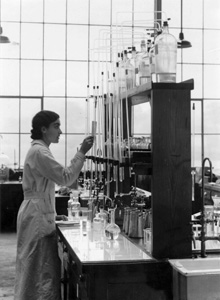
William Hobson Mills FRS was a British organic chemist.
Sir James Walker FRS FRSE FCS LLD was a Scottish chemist.

Lucy Everest Boole FRIC was a British chemist and pharmacist who was the first woman to research pharmacy in England. She was the first female professor at the London School of Medicine for Women in the Royal Free Hospital, and the first female Fellow of the Royal Institute of Chemistry.

Grace Coleridge Frankland known as Mrs Percy FranklandnéeGrace Toynbee was an English microbiologist. She was one of the nineteen female scientists who wrote the 1904 petition to the Chemical Society to request that they should create some female fellows of the society.

Edith Ellen Humphrey was a British inorganic chemist who carried out pioneering work in co-ordination chemistry at the University of Zurich under Alfred Werner. She is thought to be the first British woman to obtain a doctorate in chemistry and the first chemist to synthesize a chiral inorganic complex.
Kathleen Culhane Lathbury was a British biochemist known for her work with insulin and vitamins. Lathbury worked as an overseer at British Drug Houses where she was responsible for supervising the manufacture of insulin to make sure it was effective. After her retirement she took up painting and was exhibited in the Royal Academy. She was still driving at the age of 90. She had three sisters, Norah, Rosalind, Christine and two brothers, Robert, and Michael who all had equally remarkable lives

Sibyl Taite Widdows was a British scientist and member of the chemistry department at the London School of Medicine for Women for 40 years.
Mildred May Gostling, also published under her married name Mildred Mills, was an English chemist who completed research in carbohydrate chemistry. She was one of the nineteen signatories on a letter from professional female chemists to the Chemical Society requesting that women be accepted as Fellows to the Society.
Mary Beatrice Thomas was a lecturer in chemistry at Royal Holloway College and later at Girton College, Cambridge where she was also Director of Studies. She was a noted educator, co-editing a chemistry textbook written by Ida Freund, as well as being one of the nineteen signatories to a petition to the Chemical Society arguing for admission of women as Fellows of the Society.

Margaret Seward MBE became the earliest Chemist on staff at the Women's College, from 1896 to 1915. She became the pioneer woman to obtain a first class in the honour school of Natural Science and later received an MBE for her work on nutrition during World War I.
Katharine Isabella Williams was a British chemist who became a student, aged 29, at University College Bristol. She was known for her collaboration in the 1880s with Nobel prize winning Scottish chemist, William Ramsay and was also one of the signatories of the 1904 petition for the admission of women to the Chemical Society.
The 1904 petitionto the Chemical Society was a petition written by 19 female chemists setting out the reasons why they should be afforded the status of Fellow of the Chemical Society. The petition is of importance as it eventually led to the admission of women as Fellows of the Society, as well as identifying prominent female chemists working in Britain at this time.
Emily Comber Fortey was a British chemist and politician. She gained her B.Sc. in 1886 before working with Vladimir Markovnikov and Sydney Young on fractional distillation. In 1904, she was one of nineteen signatories on a petition to allow the admission of women to the Chemical Society.
Hilda Jane Hartle was a British chemist researcher and teacher. She was prominent in promoting the teaching of Chemistry to women and became known for her opposition to domestic science.
Clare de Brereton Evans was a scientist and academic who became the first woman to be awarded a doctorate in Chemistry (DSc). She was a pioneer translator of Meister Eckhart's German works.
Katherine Alice Burke was a British chemist and one of the nineteen signatories of the 1904 petition to the Chemical Society.
Alice Emily Smith was a British chemist and one of the nineteen signatories of the 1904 petition to the Chemical Society.
Annie Homer was a biochemist at Newnham College, Cambridge, University of Toronto and the Lister Institute. She developed improved methods for large-scale production of antitoxin sera during World War I.
Ether Margaret Luis was a Scottish chemist who was one of the first women appointed to the chemistry staff of the University of Dundee during the Second World War.
Millicent Taylor FRSC MSc DSc was a chemist who, in 1904, was one of the nineteen women who petitioned to join the Chemical Society







